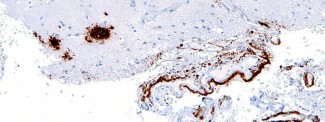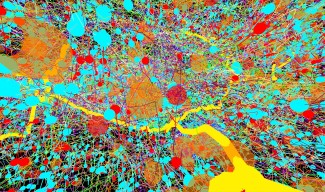Several recent studies confirm that the presence of senile plaques or the beta-amyloid protein permit the diagnosis of Alzheimer disease or predictions as to who will develop the disease.
The degeneration of neurons in Alzheimer disease is due in part to abnormal accumulation of a protein called beta-amyloid peptide (Aβ peptide) outside nerve cells, leading to the formation of "amyloid plaques," also called "senile plaques."
Découvrez toutes nos vidéos sur notre page dédiée.
The most important study of senile plaques in the human brain confirms that the presence of beta-amyloid can help determine who has Alzheimer disease, and especially who will develop the disease. This study was performed by an international consortium including Pr. Harald Hampel of the Pierre and Marie Curie University and Institut du Cerveau - ICM researchers in the "FRONTLAB" team (Frontal systems: functions and dysfunctions" directed by Prs. Bruno Dubois and Richard Lévy.
Another study, published in May, 2015, in the journal JAMA, supports the central and precocious role played in the disease by beta-amyloid, the protein implicated in the formation of the plaques mentioned above. The data show that the amyloid protein can appear 20 to 30 years before the symptoms of dementia, and the great majority of Alzheimer disease patients have the protein.
An estimated 35.6 million persons are affected by Alzheimer disease worldwide. Alzheimer disease thus represents an important risk for the aging population and their families. It is predicted that these figures will almost double every 20 years, reaching 65.7 persons in 2030 and 115.4 million in 2050. Alzheimer disease is a challenge for public health worldwide: it's the most frequent neurodegenerative disease, a major worldwide epidemic that exerts increasing pressure on our health systems and societies.
Recent proof of a silent stage of the disease, which lasts approximately ten years during which no clinical symptoms are evident but biological markers can be observed, shows that it is possible to accelerate early detection of Alzheimer disease. To this end, a study was performed to identify potential biomarkers of onset of the disease.
Pr. Harald Hampel occupies the chair AXA-UPMC "Anticipate Alzheimer disease" of Sorbonne Universities. He also participates in the key research program INSIGHT directed by Pr. Bruno Dubois (INveStIGation of AlzHeimer’s PredicTors in Subjective Memory Complainers) ongoing in the Institut du Cerveau - ICM, the Hospitalo-University Institute (IHU-A-Institut du Cerveau - ICM), the IM2A (Institute of memory and Alzheimer disease) and the Pitié-Salpêtrière Hospital.
Identify diagnostic or predictive markers of Alzheimer disease, notably 20 to 30 years before the symptoms of dementia appear, is today a major challenge.
Sources
https://pubmed.ncbi.nlm.nih.gov/25988463/
Ossenkoppele R et al. JAMA. 2015 May 19;313(19):1939-49. doi: 10.1001/jama.2015.4669. PubMed PMID: 25988463; PubMed Central PMCID: PMC4517678.
https://pubmed.ncbi.nlm.nih.gov/25988462/
Jansen WJ et al. Prevalence of cerebral amyloid pathology in persons without dementia: a meta-analysis. JAMA. 2015 May 19;313(19):1924-38. doi: 10.1001/jama.2015.4668. PubMed PMID: 25988462; PubMed Central PMCID: PMC4486209.







